Koblenz delights visitors with its rich history and picturesque landscapes, offering numerous attractions and monuments. One of the most characteristic places in the city is the Deutsches Eck or German Corner, where the mighty Rhine and Mosel rivers meet. Here you can admire the impressive monument to Kaiser Wilhelm I and beautiful views of the surrounding waterways. It is also worth discovering the charming Rhine Valley, a UNESCO World Heritage Site, known for its magnificent castles and hills.
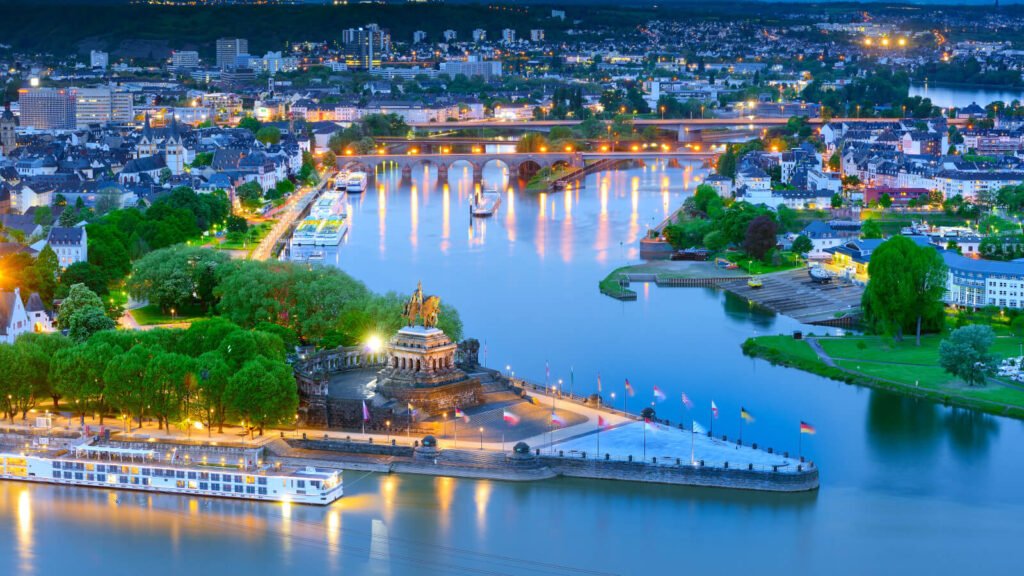
The historic Old Town with its medieval architecture and picturesque cobbled streets and the bustling market where you can sample fresh produce and artisan products are popular and frequently visited places.
Location
Koblenz is a charming city located where the Moselle meets the Rhine in western Germany. The city is located in the Rhineland-Palatinate region.
Ehrenbreitstein Fortress
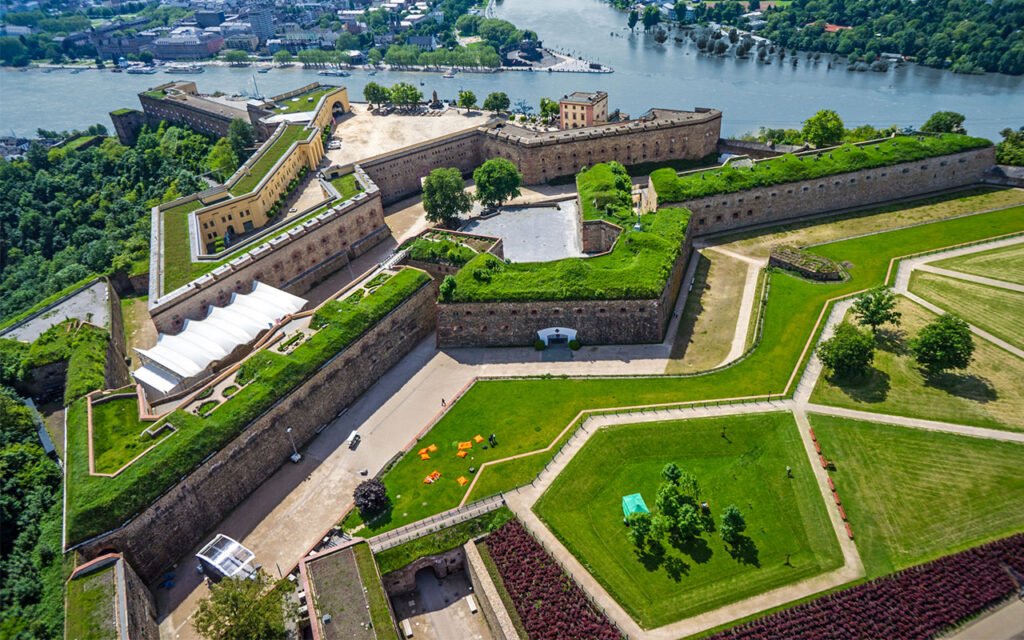
Ehrenbreitstein Fortress on the eastern bank of the Rhine where it meets the Moselle, overlooking the city of Koblenz.
Occupying the site of an earlier fortress destroyed by the French in 1801, it was built as the backbone of a regional fortification system, the Festung Koblenz, by Prussia between 1817 and 1828, and guarded the Middle Rhine region, an area that had been repeatedly invaded by French troops before. The Prussian fortress has never been attacked.
Schloss Koblenz – Kurfürstliches Schloss (Castle)

The Electoral Palace in Koblenz was the residence of the last Archbishop and Elector of Trier, Clemens Wenceslas of Saxony, who built the palace in the late 18th century. The castle consists of a main building in an elongated, rectangular shape. On the Rhine side, there is a central projection with six columns in front and a bas-relief depicting the allegory “Rhine and Moselle” by sculptor Sebastian Pfaff. The lower, round wings are immovable.
Guests have access to 4 exclusive rooms with an area of 100 – 370 m² in a historical setting, equipped with the latest technology. Conference and event technology is available. In addition to corporate events, conferences and concerts, the facility can also be used for private celebrations.
Stolzenfels Castle

Stolzenfels Castle is located near Koblenz, this majestic building is an example of the Rhine romanticism of the time. Stolzenfels Castle was built around 1830 on the ruins of Stolzenfels Castle.
The highlight of the guided tour of the castle, which is impressive even from a distance, is the Knights’ Hall. A popular place for princesses, knights and noblemen.
Marksburg Castle

The Marksburg Castle (was known as Burg Braubach) rises high above the right bank of the River Rhine, crowning a cone-shaped hill overlooking the town of Braubach. The Marksburg is the only hilltop castle on the Middle Rhine to escape destruction or ruin.
The building is the historic seat of the von Eppstein, Katzenelnbogen and Princes of Nassau families, existing before 1231.
Deutsches Eck
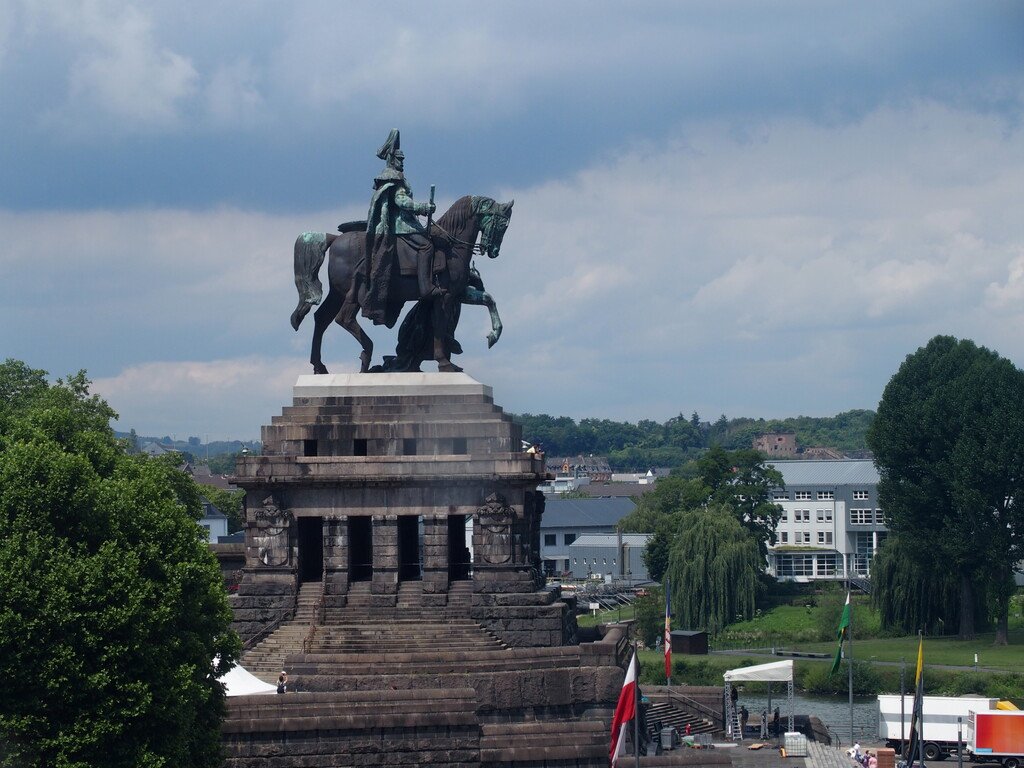
The Deutsches Eck is a large monument to Emperor Wilhelm I. The monument is located exactly at the mouth of the Moselle and the Rhine. The name of the artificially created headland comes from the “real” Deutsches Eck, the neighboring cross of the Teutonic Order in Koblenz.
Seilbahn Koblenz
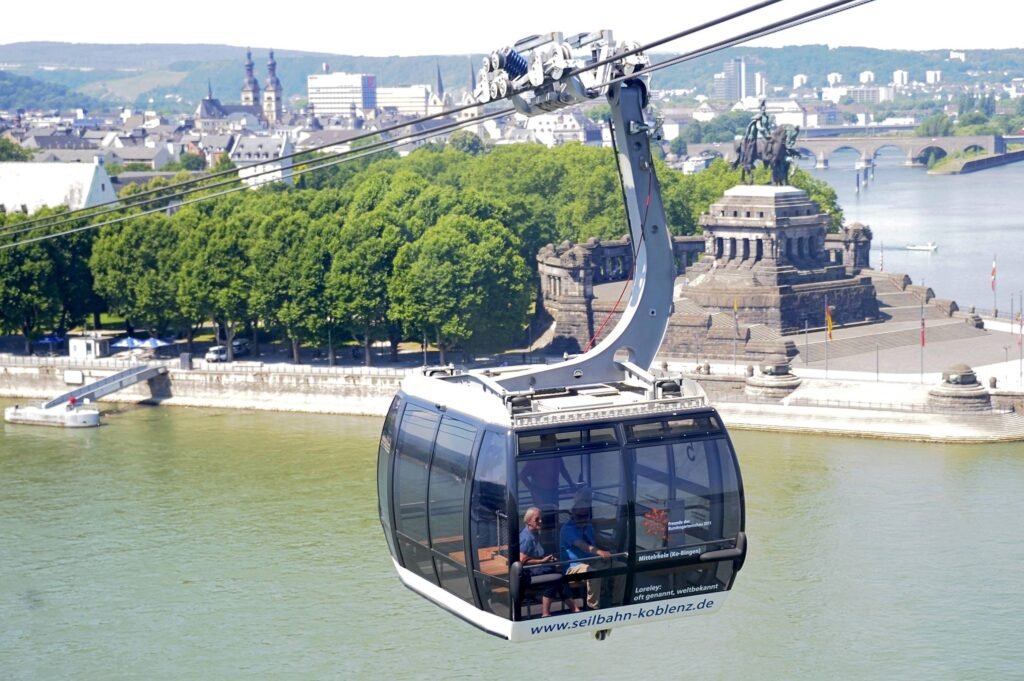
This aerial cable car was built for the Federal Garden Show in Koblenz between the plateau of the German Corner in Koblenz and Ehrenbreitstein Fortress.
The cable car covers a distance of almost 850 meters and offers breathtaking views of the confluence of the Rhine and Moselle rivers through the large panoramic cabin windows.
Schängel Fountain

The Schängelbrunnen is the symbol of the city of Koblenz and is located on the Willi-Hörter-Platz square (today’s town hall courtyard), surrounded by Renaissance buildings. Today, all native Koblenz residents consider themselves Schängel and adore this little man, who is a symbol of wit, quick wit and the Rhineland lifestyle.
History Column
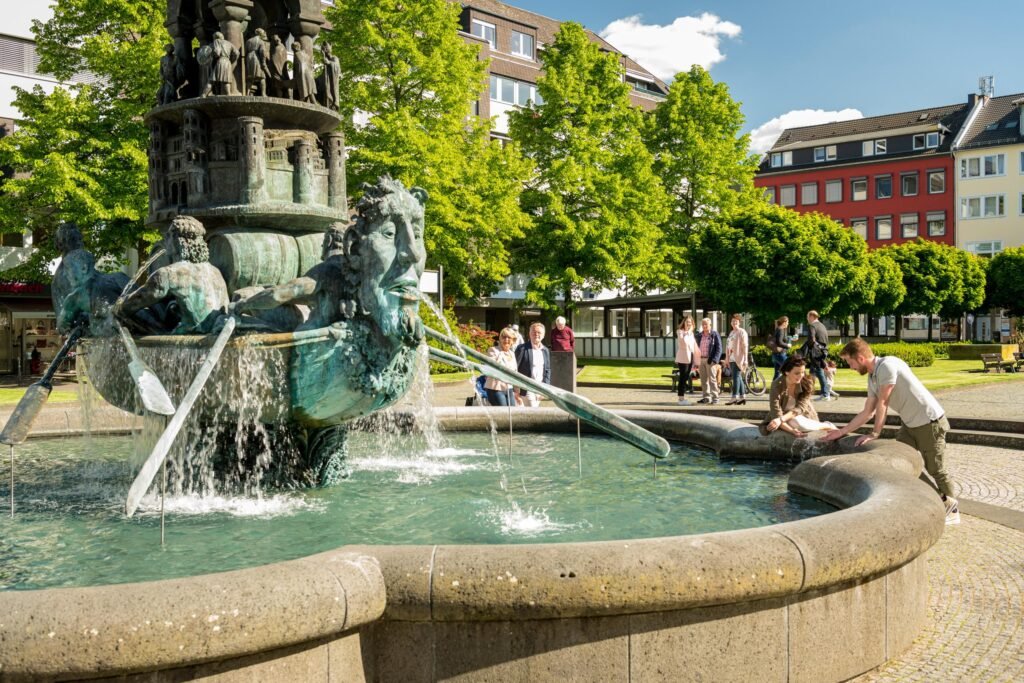
The square was named after the famous poet Josef Görres. Here you can see an interesting historical column called Historiensaeule, which was created in 1992. It is 10 meters high and was created by Jürgen Webers.
It shows the history of Koblenz from the Romans (at the bottom of the fountain), the French and Prussian times, the destruction of World War II up to the present day.
Basilica of St. Castor
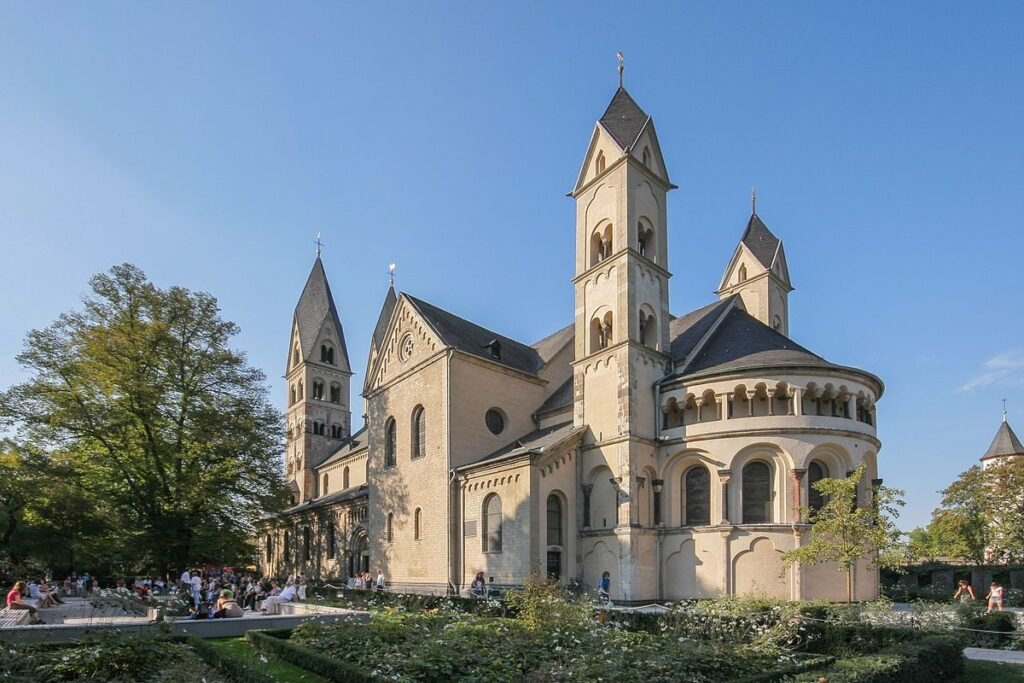
The Basilica of Saint Castor is the oldest church in Koblenz. It is located near Deutsches Eck at the confluence of the Rhine and the Moselle. The St. Castor Basilica is the oldest preserved church in Koblenz. The collegiate church, consecrated in 836, was the scene of significant historical events.
The building in its present form dates mainly from the middle of the 12th century. On July 30, 1991, Pope John Paul II elevated the Castor church to the status of basilica minor.
Liebfrauenkirche (Church of Our Lady)
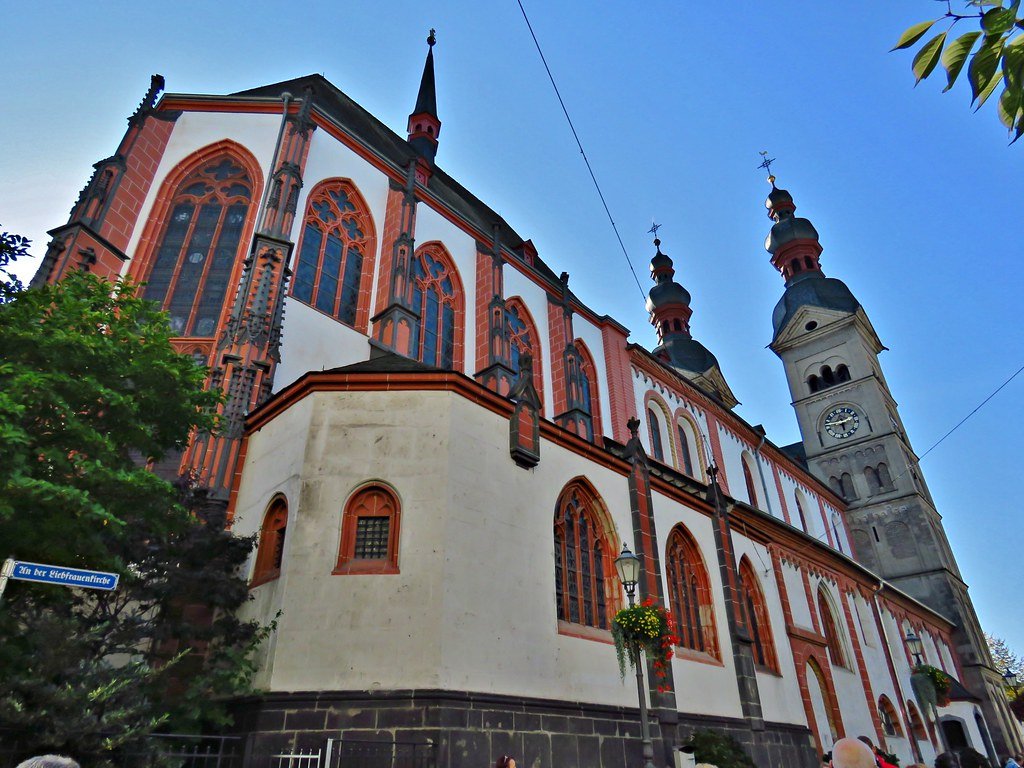
The Church of Our Lady is one of three Romanesque churches that characterize the appearance of Koblenz’s old town.
From its very beginning, the Church of Our Lady was (along with St. Castor) the parish church of Koblenz. The origins of the church date back to the 5th/6th centuries.
DB Museum Koblenz

The DB Museum Koblenz presents a collection of vehicles that includes around 40 historic locomotives and 50 passenger and freight cars.
In the DB Museum Koblenz, visitors can learn about the history of railways in Germany in an interactive exhibition. The DB Museum Koblenz is located in a former freight car repair shop in the Lützel district.
Defence Technology Study Collection Koblenz

The Scientific Collection of Defense Engineering Specimens (Wehrtechnologe Studiensammlung – WTSWehrtechnologe Studiensammlung) is one of the largest technical collections in the Federal Republic of Germany. It was founded in 1962, has been based in Koblenz.
It documents the technical progress of defense materiel and provides expertise for the development of materiel. In addition, it provides basic and advanced training to personnel specializing in the field of defense technology and to prepare soldiers for operations abroad, for example. WTSWehrtechnologe Studiensammlung also runs an exhibition which is open to the public and which showcases part of the collection: approximately 2,500 exhibits on 7,200 m² of exhibition space.
